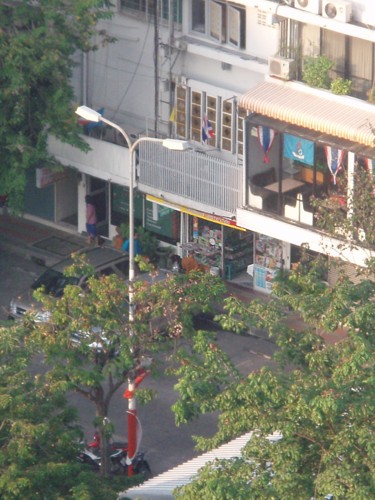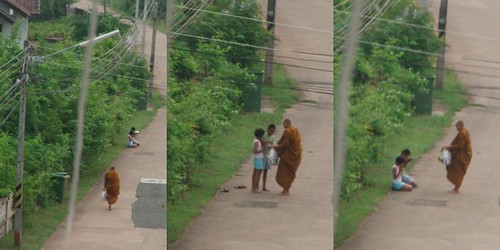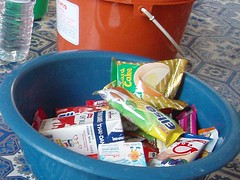Every morning, monks & novices in Theravada Buddhist countries emerge from their temples to collect alms (บิณฑบาต bindabaat) from laypeople in their communities. Traditionally they set off at dawn, once there is enough light to make out the lines on the palms of one's hands. In modern times with street lighting & when people have to rush off to work & school, the local community & temple work out their own timings. Some temples still sound their drums to alert the neighbourhood just before their monks set off (e.g. Wat Xieng Nyeun in Vientiane capital), some no longer do so.
In most places the monks & novices split into small groups to cover different parts of the neighbourhood. Some monks walk alone on separate routes, for example in urban commercial areas where there are fewer households to give alms. Lone monk collecting alms in Siam Square, one of the main hotel + shopping mall areas of Bangkok:

This distributes the work of having to prepare food for all monks & novices of the local temple among the entire community - there is only so much a few households can give, especially in poorer areas. Laypeople also bring food directly to the temple in pots & tiffin carriers & offer it to the monks there - a more environmentally friendly option as compared to the common practice of wrapping several individual packages for each monk/novice in separate plastic bags.
Bindabaat is a barefoot affair for both giver & receiver, & the former (sometimes with the exception of men who have been ordained before) keep their heads at a level lower than that of the monks. In some places that are accessible only by water, monks go on bindabaat on rowboats (e.g. some canals in Bangkok, Samut Songkhram & Nakhon Pathom in Thailand, & Inle lake in Burma). In the mountains of Chiangrai, those from วัดถ้ำป่าอาชาทอง Wat Tham Pa Acha Thong (made famous by the documentary 'Buddha's Lost Children') go on horseback. After receiving the alms, the monk stands aside & chants a Pali blessing expressing gratitude for the offerings & wishing the almsgiver safety, happiness, good health & a long life:

The first time the cat saw monks & novices standing in separate groups instead of together in one line to chant the blessing:

Each place works out its own variation of the practice based on the local situation & cultural norms, 'same same but different'...
Unlike in the Mahayana tradition where only vegetarian food may be offered, Theravada (& Vajrayana) monks can consume any non-vegetarian food placed in their alms bowls except for meat from certain sources (e.g. humans, elephants, horses, tigers, dogs, bears, etc). In most parts of Thailand where khao jaao (soft non-glutinous rice) is offered, people usually ladle it into the alms bowls using spoons. In Laos where khao niao (harder sticky rice) is the norm, people simply use their hands. In modern times, packaged junk food has become a convenient, more hygienic & popular (but arguably less healthy & environmentally friendly) option:

Non-edibles such as flowers & cash can also be given. Many many years ago, the much younger cat learnt the hard way with a *SMACK* from an aunt that flowers to be offered during taak baat (giving of alms) should NEVER be sniffed.
According to the training rules (sekkhiya) the contents of an alms bowl should not exceed the brim. But the onus is on the monks to give everyone the chance to make merit through giving them alms i.e. not to refuse any. Refusal of alms (pattanikkujjana) is tantamount to punishment of the almsgiver, as demonstrated by the Burmese sangha's refusal to accept alms from the military during the Saffron Revolution in 2007. In Thailand, temple boys tag along on pindabaat, sometimes even pushing a cart, to help carry alms when there is more than what can fit into the alms bowls & bags. There, the cat has seen people piling offerings on top of the closed lid of the alms bowl (high expectations of the monk's balancing skills), & 'overloaded' monks returning to the temple by samlor.
Usually everything collected by all the monks & novices of the same temple is pooled & then served together on return. Thus everyone gets a fair share, including those who've collected less, those who've stayed in due to illness or injury, those who overslept & woke up to find that everyone had left without them (:P), & even those who 'didn't bother' (!! but well, they help to increase respect for those who do bother :P). Although in many temples, the cat has seen monks being allowed to keep some of their alms (especially money) for themselves & eat separately in their own rooms. The cat also has heard of temples where absolutely everything (including cash) has to be pooled, & some monks of the Dhammayut sect who mix everything there is in their alms bowl & eat the resulting 'mess' as it is - food being strictly for sustenance rather than enjoyment.
With certain exceptions, monks are not supposed to store alms food & eat it the next day or later. Discourages greed, & makes a lot of sense in the old days before refrigerators & artificial preservatives - the precepts were set down more than 2500 years ago. The food collected will be eaten for breakfast, & leftovers for lunch (before 12:00PM), แม่ชี mae chii (mae khao in Laos, don chii in Cambodia, or thila shin in Burma - women who wear white robes & observe 5, 8 or 10 precepts but are not technically nuns), laypeople including temple boys, orphans under the care of the temple & visitors. Finally, whatever still remains is left out for temple cats, dogs, birds & even ants (which are quite good at getting to the food even before the monks :P). Ideally nothing is wasted. Poor families send their kids to wait for such food at their neighbourhood temple, & beggars & the destitute hang around there for the same reason. Because the rich can & tend to give more (more merit gained!), this effectively serves as a 'system for redistribution' of community resources that avoids loss of 'face'/dignity (the poor having to beg the rich directly for food). Although it does not live in any temple, this cat has helped to finish off some leftover alms food & been made to take some home before :P
In Burma & a few places in Thailand, mae chii do go on bindabaat, but many Thais hold onto the belief that greater merit is to be gained by giving to monks than to mae chii, because the latter are female & being unordained, have a lower status :| Likewise, some believe that greater merit comes from giving to monks than directly to poor or disadvantaged laypeople, although this is more of a local 'interpretation' of Buddhist teachings. As a result, most mae chii end up being totally dependent on the monks in their temple or even their families to provide them with food, & quite a few don't always have enough. Some lucky ones live in temples with abbots & lay devotees who support them (e.g. วัดปากน้ำภาษีเจริญ Wat Paknam Phasi Charoen in Bangkok, where some of the Lao 'consultants' have stayed at before), or have sons or other male relatives who are monks or novices in the same temple & will set aside food for them. Interestingly, a Lao 'consultant' told the cat that a Thai teacher of English in his Buddhist university didn't know the English word 'nun' (the most convenient & common but technically incorrect translation for mae chii used in Thailand)...
This was essentially what the cat knew about bindabaat before it ever came to Luang Prabang...






No comments:
Post a Comment